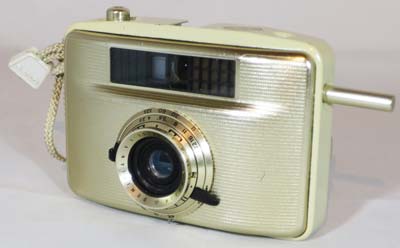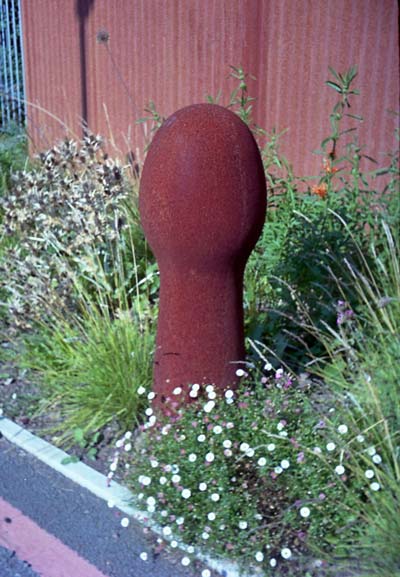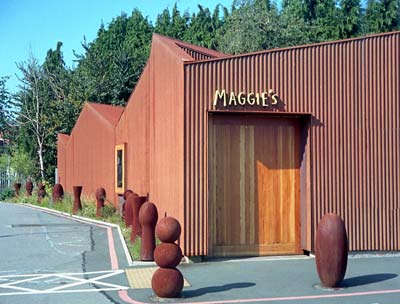Welta Penti II
Specification


| Manufacturer | : | VEB Welta-Kamera-Werk |
|---|---|---|
| Produced | : | 1961 - 1977 |
| Classification | : | Miniature |
| Body Type | : | Solid Body |
| Construction | : | Cast Aluminium & pressed steel |
| Film Type | : | Rapid |
| Film width | : | 35mm |
| Image Size | : | 24mm x 18mm |
| No. of Images | : | 12 |
| Lens Type | : | Meyer-Optik Domiplan V coated 3-elements |
| Focal Length | : | 30mm |
| Focus Type | : | Variable |
| Focal Range | : | 1m - inf. |
| Aperture Type | : | Iris |
| Apertures | : | f/3.5 - f/22 |
| Shutter Type | : | Twin-Blade Metal Leaf |
| Shutter Speeds | : | B, I(1/30s, 1/60s, 1/125s) |
| Exposure Meter | : | Selenium |
| Flash | : | PC type connector |
| Size (w x h x d) | : | 105 x 75 x 48 mm |
| Weight | : | 285g |
Art Deco Credentials
![]()
![]()
Acceptable: Modest and restricted
- Produced after the main Art Deco period.
- Metallic gold pressed steel on front and back.
- Geometric pattern on face plate and back.
- Curvilinear body shape.
Description
The original 'Penti' camera was designed and produced in 1958 as the Welta Orix at the VEB Welta Kamera Werke factory. The name Orix was however quickly changed after one year to Penti. A newer version called the Penti II was made from 1961 to 1977 by the Object 10 factory in Helfenberg. Welta would be absorbed into VEB Pentacon in 1964 while this camera was still in production, so many were made after the merger and were then called the Pentacon Penti II. A simpler variant of the Penti II called the Penti I, without metering, was also made but was discontinued before 1966. Some 800,000 cameras were produced from 1958 to 1977.
The camera was designed specifically for the female consumer in a male dominated market. The advertising leaflet for the camera shows what a charming lady should take when leaving home. As well as her normal accessories of a necklace, earrings and ring, the Penti II was shown as an essential addition to give that finishing touch to her lifestyle.
These cameras have a front & rear gold plate as well as a gold trimmed Meyer-Optik Domiplan lens. The middle part of the body is cast aluminium and came in a variety of colors like black, white, ivory, teal, and even pink. This camera uses a type of film cartridge called 'Rapid' that holds 12 35mm full frames. However, the camera takes half frames and so you get 24 photographs from the cartridge. The camera is loaded with a light tight Rapid film cartridge which holds the film. The film advance mechanism transfers the film into a similar cartridge on the other side of the camera. The film is not rewound and the receiving cartridge is taken for developing. When the camera is held normally it produces portrait oriented images, half the size of the normal 35mm images.
The focus and exposure controls are found on concentric dials around the lens. Speeds are B, 1/30, 1/60, 1/125, apertures f/3.5 to f/22 and a focus ring for 1m to infinity. The annotation allows the user to ascertain the depth of field for apertures f/5.6, f/8 and f/11.
The Penti II has a built-in selenium based lightmeter working in shutter speed priority. A tab allows you to choose film DIN values of 15,18,21 and 24. This is equivalent to ISO 25, 50, 100 and 200. Once the speed and ISO are chosen, then the aperture is rotated to bring a moving marker in-line with a fixed marker. When these two are aligned as close as possible then exposure will be good. As far as I could ascertain, the meter on the example I have still works OK.
Film advance is via a horizontal rod that protrudes from the left side of the camera. When this is pushed in, a ratchet system engages with the film sprockets to move it on. There is a spring loaded plate that holds the film flat on the track and guides it into the second cassette. This action also sets the shutter mechanism. When the shutter fires, the rod returns to it's resting position. There is a photo counter on the top that needs to be manually reset when loading the film.
The top of the camera has a PC flash socket and a central flash mounting slot. The shutter release button is threaded to take a remote release cable. There is one tripod mount on the base.
How to Use
Here is the manual for the Penti I in German. Manual Penti I. The Penti I does not have the exposure meter so reference to this is not in the manual.
The Rapid cartridges are no longer produced. It is possible to load a Rapid cassette with 35mm film in a dark room or changing bag. If you do not have any Karat/Rapid cassettes you can simply load the camera with bare film. See more about how to use 35mm film in this camera here:- Loading Cameras that use Karat or Rapid cassettes
If you are going to use the internal exposure meter, try this simple test first. Set the DIN value to 21 (ISO 100). Set the speed value to 125. Set the aperture to f/16. On a sunny day, point the camera at an average scene or at the blue sky away from the sun. The fixed needle and the moving needle should reasonably coincide.
If you don't want to bother with the exposure meter or it is not working, follow the guide shown. It is based on the 'Sunny 16' rule. Film is so forgiving and will produce acceptable results even when overexposed by 2 or 3 stops or underexposed by 1 stop.
Shutter speeds are 1/30s, 1/60s and 1/125s although the accuracy is not guaranteed. The aperture range is f/3.5 to f/22
The tables assume that the sun is at least 30 degrees above the horizon - that's 10am - 5pm on a summer's day in the UK.
If you are not sure about the light level, err on the side of overexposure - i.e. assume the smaller f number.
Where there is a choice, a larger f number will give a larger depth of field.
For the slower speeds, you may need a tripod to stop blur through shake.
Using ISO 100/125 film
| Weather Conditions | Shadow Detail | Shutter Speed (s) | ||
|---|---|---|---|---|
| 1/30 | 1/60 | 1/125 | ||
 Sunny SunnySnow/Sand | Dark with sharp edges | - | - | f/22 |
 Sunny Sunny | Distinct | - | f/22 | f/16 |
 Slight Overcast Slight Overcast | Soft around edges | f/22 | f/16 | f/11 |
 Overcast Overcast | Barely visible | f/16 | f/11 | f/8 |
 Heavy Overcast Heavy Overcast | None | f/11 | f/8 | f/5.6 |
 Open Shade Open Shade/Sunset | None | f/8 | f/5.6 | f/4 |
Photographs taken with this Camera
Kodak Portra 160 35mm film in Rapid Cartridge.
Developed in Tetenal.



